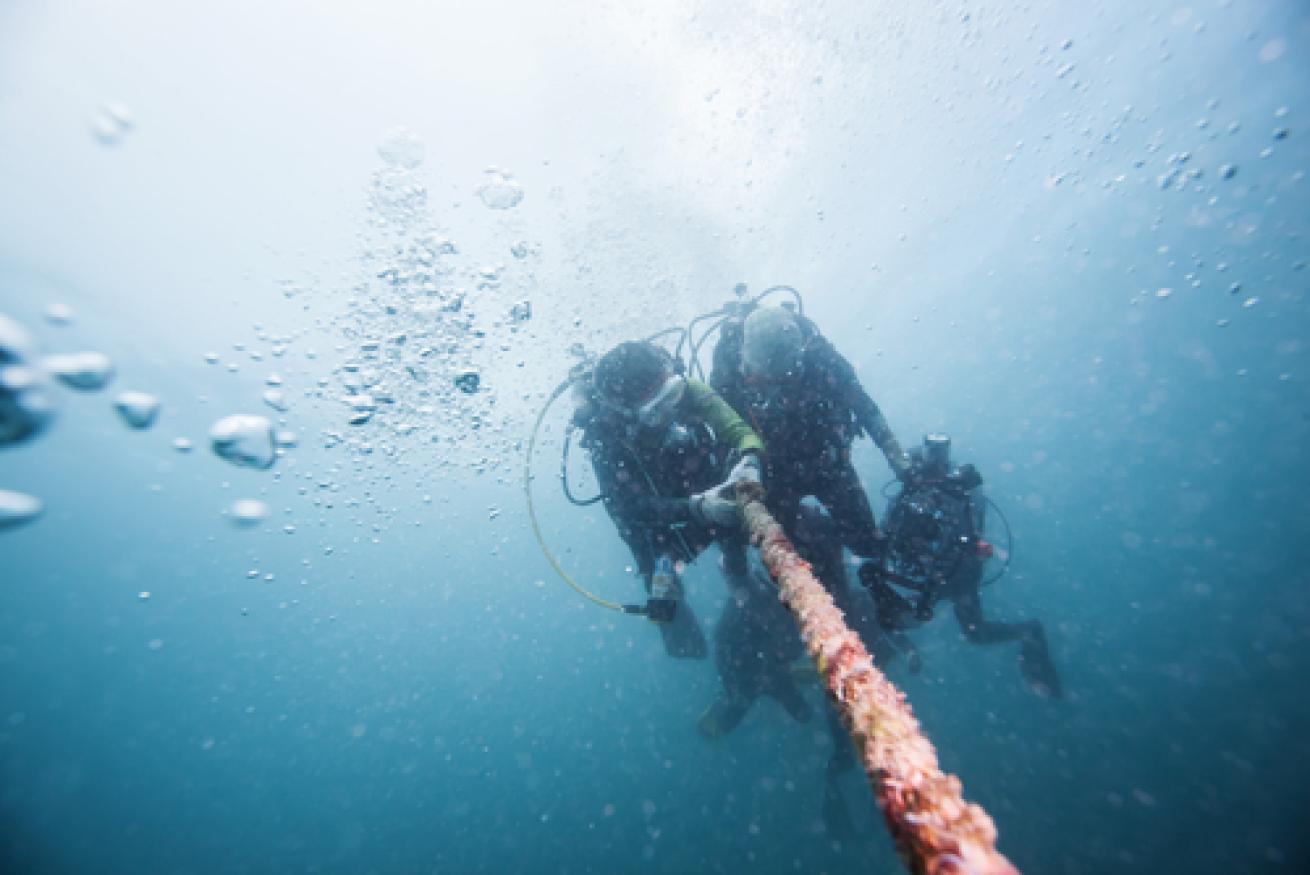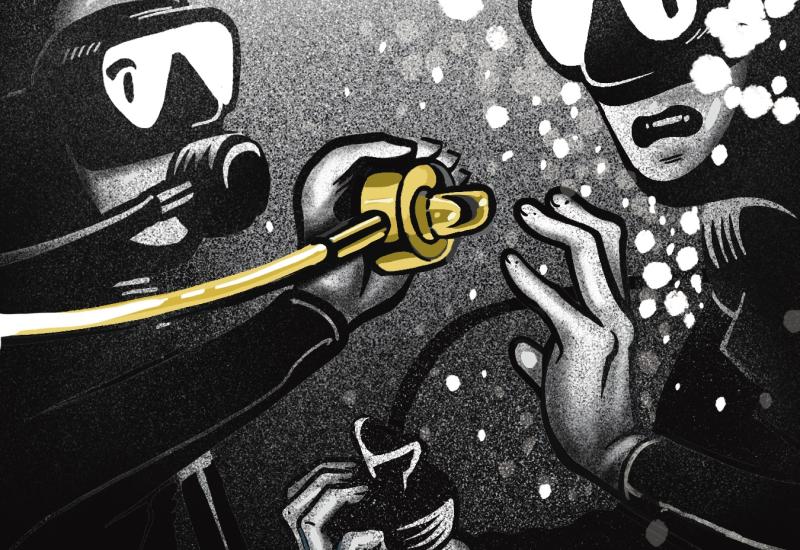Going Deep

Divers descending
Shutterstock
Setting the Stage
Jerry was an occasional diver who made most of his dives when traveling on vacation. Being single, he usually traveled alone, but sometimes a non-diving friend joined him.
While on an island vacation, Jerry found a dive operator offering a mid-week deep dive to an offshore rock pile that featured black coral and rare fish. Although Jerry had not been diving recently, when the dive operator asked about his dive experience, Jerry implied that he had much more experience than he actually did and signed up for the advanced dive.
The dive plan was first to anchor the boat in the sand beside the rock pile. Next, after a thorough briefing, the divemaster would lead the six divers down the anchor line, and then put a lift bag on the anchor to make retrieval easier. The divers would then explore the site. After 10 minutes in warm, clear, calm waters, ranging in depth from 135 to 150 feet, the group would proceed up the anchor line, making a decompression stop and a safety stop, and then head back to the boat. A hang tank would be provided at 15 feet in case anyone ran low on air during the stops.
The Dive
The first sign of difficulty came when Jerry arrived at the dive store the morning of the dive. The divemaster for the trip discovered that Jerry needed to rent much of his gear and that he had no dive computer. Then, on the trip out, the divemaster thought that Jerry's excessive chatter about dives he had made did not ring true. But, by this time, the divemaster felt he needed to press on with the dive.
The anchoring and briefing went as planned, although the current was stronger than the divemaster had planned for. Descending on the anchor line was a bit more work than expected, but all the divers arrived on the bottom, gave the OK sign and proceeded to explore the near side of the rock pile, which was the lee side, out of the current. Meanwhile, the divemaster set the anchor and attached the lift bag. Jerry had swum off to the deeper end of the rocks at 145 feet, but was still in view.
After a couple of minutes, when Jerry had not returned to the group, the divemaster swam to him and found him motionless, unconscious and not breathing. The divemaster grabbed Jerry, towed him to the anchor line and started to ascend, abandoning the other five divers.
Because the current was strong and Jerry was not breathing, the divemaster skipped the stops. As soon as they were on deck, CPR was started. Efforts to revive Jerry failed, and he was pronounced dead at a local hospital.
Analysis
What most likely befell Jerry is known as deep-water blackout, a little understood and fortunately relatively rare accident. Deep-water blackout most often occurs during dives beyond 130 feet on air, and to divers with little or no experience in the particular demands of this type of diving. Deep-water blackout may be related to fitness, narcosis, gas density, carbon dioxide retention and breathing resistance, but none of this is clearly understood.
Lessons for Life
-
Scuba diving takes practice to keep skills fresh. Refresher and advanced courses are ideal for this.
-
Be honest with yourself and others concerning your diving experience.
-
Do not engage in deep or decompression diving unless you have the training and experience to do so. Some training agencies now offer training in extended-range diving--diving beyond the usual recreational limits.
-
If you are going to make serious or demanding dives, you should have your own high-performance regulator, instruments (including both a dive computer and a compass) and BC.

ShutterstockDivers descending
Setting the Stage
Jerry was an occasional diver who made most of his dives when traveling on vacation. Being single, he usually traveled alone, but sometimes a non-diving friend joined him.
While on an island vacation, Jerry found a dive operator offering a mid-week deep dive to an offshore rock pile that featured black coral and rare fish. Although Jerry had not been diving recently, when the dive operator asked about his dive experience, Jerry implied that he had much more experience than he actually did and signed up for the advanced dive.
The dive plan was first to anchor the boat in the sand beside the rock pile. Next, after a thorough briefing, the divemaster would lead the six divers down the anchor line, and then put a lift bag on the anchor to make retrieval easier. The divers would then explore the site. After 10 minutes in warm, clear, calm waters, ranging in depth from 135 to 150 feet, the group would proceed up the anchor line, making a decompression stop and a safety stop, and then head back to the boat. A hang tank would be provided at 15 feet in case anyone ran low on air during the stops.
The Dive
The first sign of difficulty came when Jerry arrived at the dive store the morning of the dive. The divemaster for the trip discovered that Jerry needed to rent much of his gear and that he had no dive computer. Then, on the trip out, the divemaster thought that Jerry's excessive chatter about dives he had made did not ring true. But, by this time, the divemaster felt he needed to press on with the dive.
The anchoring and briefing went as planned, although the current was stronger than the divemaster had planned for. Descending on the anchor line was a bit more work than expected, but all the divers arrived on the bottom, gave the OK sign and proceeded to explore the near side of the rock pile, which was the lee side, out of the current. Meanwhile, the divemaster set the anchor and attached the lift bag. Jerry had swum off to the deeper end of the rocks at 145 feet, but was still in view.
After a couple of minutes, when Jerry had not returned to the group, the divemaster swam to him and found him motionless, unconscious and not breathing. The divemaster grabbed Jerry, towed him to the anchor line and started to ascend, abandoning the other five divers.
Because the current was strong and Jerry was not breathing, the divemaster skipped the stops. As soon as they were on deck, CPR was started. Efforts to revive Jerry failed, and he was pronounced dead at a local hospital.
Analysis
What most likely befell Jerry is known as deep-water blackout, a little understood and fortunately relatively rare accident. Deep-water blackout most often occurs during dives beyond 130 feet on air, and to divers with little or no experience in the particular demands of this type of diving. Deep-water blackout may be related to fitness, narcosis, gas density, carbon dioxide retention and breathing resistance, but none of this is clearly understood.
Lessons for Life
Scuba diving takes practice to keep skills fresh. Refresher and advanced courses are ideal for this.
Be honest with yourself and others concerning your diving experience.
Do not engage in deep or decompression diving unless you have the training and experience to do so. Some training agencies now offer training in extended-range diving--diving beyond the usual recreational limits.
If you are going to make serious or demanding dives, you should have your own high-performance regulator, instruments (including both a dive computer and a compass) and BC.










